If you see children being engaged in loose parts play, you can see for yourself many of the obvious benefits. Children get really involved, much more often than in adult-led activities. They seem to be having fun, and surely learning at the same time. But have you ever wondered, what are the benefits of loose parts play for children?
Loose parts play develops skills across the whole curriculum. It is child-led, and helps children strengthen their independence and sense of self. Because of its open-ended nature, loose parts play helps children explore, observe, enquire, investigate, construct, deconstruct and engage with both others and the world around them.
Loose parts play has many benefits, both for the child and for the adults involved in it. For example, it is low-cost and easy to set up. Also, there has been quite a bit of research into its effects that has discovered positive findings (Source).
I will look at some of the main benefits that it offers for both adults and children and why it’s definitely worth giving a go if it’s not something you have tried out before. Our loose parts play course is one of our most popular online courses (you can check them out here), and we have members from around the world.
I have tried to limit myself to what I think are the main fourteen loose parts play benefits, but you could probably think up at least a hundred if you wanted to!
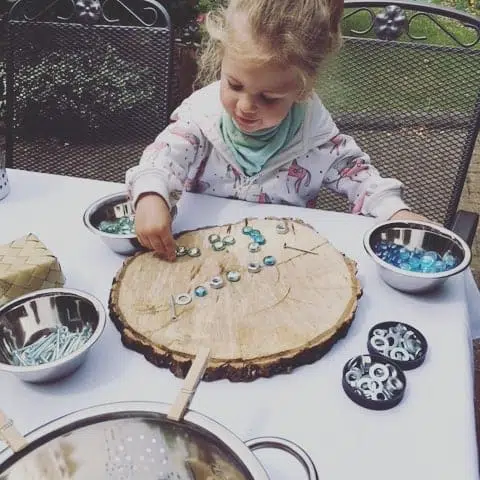
1. Important In The Modern Age
Loose parts play is timeless, and its benefits will have been the same in the past as they are now. However, many of those benefits are especially important in the modern age, as childhood is impacted heavily by a range of issues.
Loose parts play has never been so important. There are many issues that impact childhood in the modern age such as:
- Technology
- Less family time for many families
- Less space/ability for children to play outside
- Children’s time is often micro-managed
Loose parts play offers many advantages in countering some of these issues. These include:
- It develops imagination
- It connects children to reality and the real world
- They get to set their own agenda in their play
- They create their own games and narratives
- They interact with others and talk about their experiences
- It creates language-rich play where vocabulary and conversation are at the forefront
And this really only is the starting point!
Example: Some children create a river with a sheet outside, and put sticks over the river as a bridge.
2. Economy
Loose parts is one of the most frugal systems of early learning.
We live in times of serious cuts in educational funding, and widespread issues in the economy of many countries. This means many schools and families are looking for solutions that are as minimal in cost as possible.
Loose parts play is perfect for this.
At most, you only need quite a small budget to source some loose parts play materials. Realistically, a wide range of resources you will be able to find, or have lying around in your house or setting anyway. To find a list of at least 100 materials you probably will be able to find really easily then check this article out.
Examples of places to source loose parts:
- Speak to local businesses to see if they would support you in providing crates, pallets, cable reels, gutters, or anything else you can think of.
- Visit charity shops or junk-yards.
- Ask for donations of loose parts from families or friends.
- Look out for bargains on free sites.

I know a lot of schools and preschools are on very tight budgets, and this is something we always try to address in our online courses, and advice in general. You can download my free ebook ’50 Outdoor Number Activities On A Budget’ by going here. This book has been read by thousands of teachers around the world.
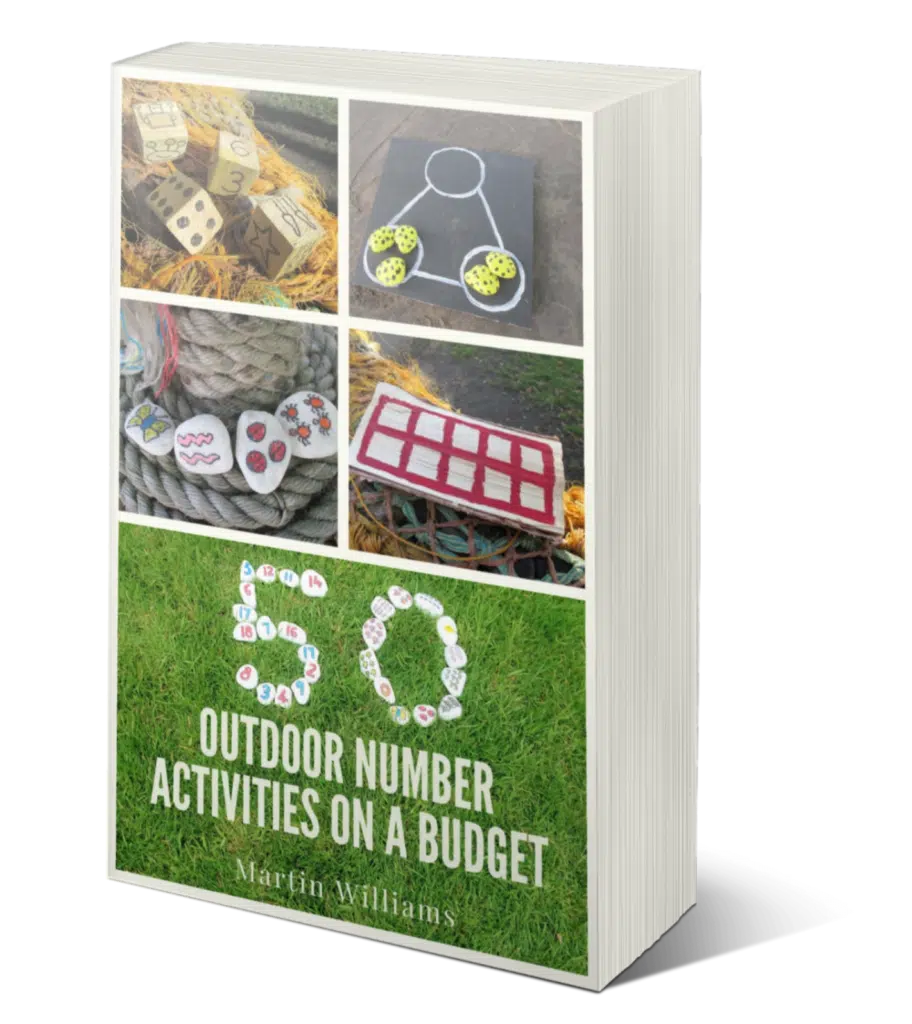
3. They Don’t Get Boring
Objects can be different things every time they play with them, so the process doesn’t become stale. A stick that is a wand one day, can be a jet plane the next.
Loose parts play offers a way of surrounding children with the same kind of resources day in and day out, but that can be used in a multitude of exciting ways.
Example: Some boys find some conkers outside. The first day, they are eyeballs left by the zombie. The next, they become gold coins that they must bury under the soil. This is the treasure. The next day, they’re pebbles. The next day, they’re snooker balls…etc etc…
4. Independence
Loose parts play is mostly child-led, and this has a tremendous impact on independence. Children get to set the agenda, think up their own ideas, and just generally think for themselves.
They become masters of their own universe, makers of their existence.
It is great for them to think for themselves and believe in themselves.
Many children these days have much less independence than they had in the past. For example, they don’t get to walk to school by themselves, play out, or roam the local neighborhood like children in the good old days.
Loose parts play reasserts the balance!
Example: A couple of girls playing with sticks outside enjoy the thrill of inventing their own idea of building a den for a hedgehog and set to work!
5. Supports Creativity
Because there is no-one to tell you how to use the things you are playing with, it supports the need to develop your own ideas.
Children come up with ideas, take on roles, speak in different voices, build imaginary objects, and inhabit fantastical worlds.
It is a back-to-basics approach.
Most toys in the modern age have a definite purpose or function. From computer games, to electronic toys, to plastic figures, what to do with toys is clear and children aren’t given any license to explore their own ideas.
This is not the case in loose parts play. When all you are faced with are a few stones and some sticks, for example, you need something to bring it all to life. That something is your own creativity!
Children start to see possibilities in objects…
They become characters of settings
They become magical tools or symbols of power
They represent other fantastical things
All in all, objects change into other things, but that takes creativity and imagination to be brought into existence.
Example: Some children use a box as a magic carpet. They sit in it and travel to far-off magical worlds.
6. You Can Use It As A ‘Hook’
Loose parts can be a great starting point.
It can be used with even children much older than 5, to spark interest in an activity. For example, get them to create transient art portraits, and then write a description of the character they have made.
Other ways you can use it as a hook include:
Creating maps and labeling them
Creating large-scale figures, and giving them a name and character description
Use objects to explore adding or number bonds, and then later start to record them.
These are just a few ideas that are included in my in-depth article – 40 Fantastic Loose Parts Play Ideas.
Example: Some children create a picture of an alien planet in the ground using stones and sticks in mud. The adult gets them to label parts of the picture.
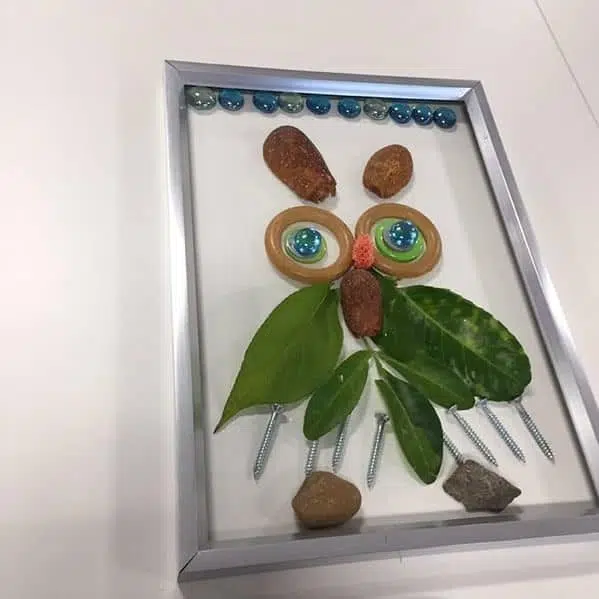
7. Gross And Fine Motor Development
Loose parts play is great for developing gross motor skills, as children will be constructing, maneuvering and transporting a range of objects.
They will be fiddling and balancing, sorting and positioning. All in all, the perfect formula for gross and fine motor development.
Children pick up screws and beads.
They post jewels into pots or use tweezers to manipulate seeds.
They can use things like geoboards, manipulating rubber bands and hair bobbles. You can find the best 16 geoboard activities to try here.
Example: Some children use tweezers to pick up black-eyed beans, and push them into some playdough.
8. Develops A Feeling Of Achievement
There is nothing quite like setting the agenda yourself, and then achieving what you set out to! Children get a thrill from creating spectacular super-vehicles, or creating a den for the witch, particularly if it was their idea in the first place.
Sometimes their play might be slightly risky. For example, they might make a ‘bridge’ made of sticks over a muddy puddle. Getting across to the other side provides a thrill and a sense of overcoming the odds.
There is an excitement in coming out on top.
There can also be that sense of achievement you get if you carry out a difficult task as part of a team.
Example: A group of children try to balance some shells in a stack. They keep falling over, but in the end they all make a tower of shells. It feels great!
9. Problem Solving
Loose parts play also helps develop problem-solving skills, as there will always be obstacles to overcome when playing loose parts.
What object could symbolize a poisoned apple in your narrative? How can you build a house for the injured bird?
Things will fall over, or not be long enough, or be too heavy, and you have to think to get past these issues.
How can you find objects to symbolize other objects?
How can you build a structure using what you can see?
Example: A girl has made a transient art picture of a house using found objects. She can’t find anything for a chimney. After searching the outside area, she finds some large stone, and she uses leaves for smoke coming out of it.
10. Supports Taking Risks
Risky play is often something parents and teachers can be reluctant to get involved with. It is often one of the central focuses of discussion during our online course and mastermind group – Project Loose Parts which you can check out here.
But risky play provides so many benefits.
Risky play provides a thrill for children in encountering danger in many controlled ways. It helps them develop emotionally and psychologically. Risky play has a huge number of benefits for children.
There is a strong practical link between loose parts and risky play, and many loose parts learning has a low level of risk that you should be aware of.
For example, children build towers and structures outside using different materials, and then they will climb or walk along them.
They will explore difficult terrain, such as muddy ground, and steep inclines, or maybe climb limbs of branches. This could be searching for loose parts, or using loose parts as part of their play, for example using a stick as a walking stick, or following a ‘map’ made of loose parts. If you want out what this kind of play looks like, then check out this article about 25 examples of risky play.
Example: Some children stack some crates up outside. They help each other to climb up the ‘tower’, checking first that it is not too wobbly.
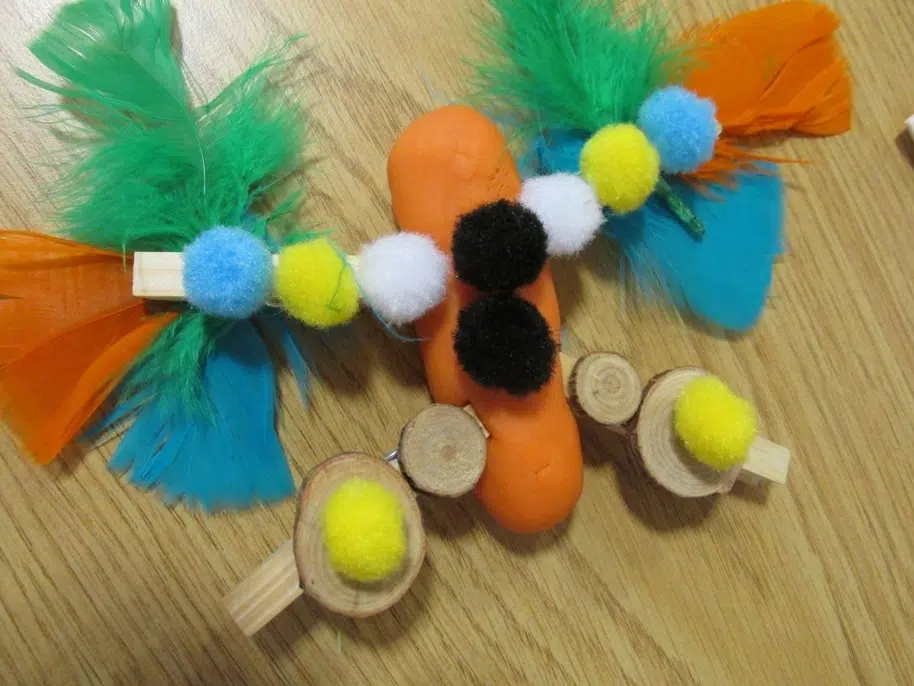
11. Develops Concentration
Children will get wholly involved in good-quality loose parts play. They will be engrossed in a way that is hard to replicate through adult-led activities.
Because they lead their own play, it gets children fired up in a unique way.
Even very young children can get really engrossed in loose parts play.
Babies and toddlers can explore treasure baskets, and investigate and explore.
Older children can be involved for a huge amount of time designing structures, hunting for materials to create something, or involved in a long narrative involving loose parts.
Example: A two-year-old packs some material into an old cardboard box, and then removes it, repeating this again and again. They do this for more than twenty minutes.
12. Emotional Development
Children will take on roles. They will learn about the world and those around them.
They will develop confidence and self-esteem, and start to understand that they are capable of great things.
There is a strong link between loose parts and stories and storytelling. Children can use loose parts to be characters that they invent or from a story they know well.
They act out stories and dialogues, and this expands their knowledge of how the world works, and how people react emotionally to different situations.
Children create faces and portraits and explore the different emotions that these can portray and what they mean.
Playdough is brilliant to use alongside loose parts, and playing with dough has many emotional benefits for children.
Example: Some children use stones, sticks and leaves to make a picture of an evil witch on the ground. They give her a name and make up a story about her.
13. Conversation And Language Development
This is a massive benefit. Vocabulary acquisition is seen by research as one of the key skills present in children who will have an economically positive life.
In loose parts play, there is often questioning, narrating, taking on roles or voices, talking through ideas, negotiating and imagining.
Children talk about what they are doing.
They ask others what they are doing as well.
They share ideas, make up funny voices, explore language they have just learned, or even make up words and phrases to describe what is going on. All in all, good quality loose parts play is one of the richest language interchanges you will ever see.
Example: Some children make a treasure map using loose parts. They take on pirate voices as they do it, and talk about the adventures they will have.
14. Develop Skills Across Curriculum
As we have mentioned before, loose parts play develops skills across everything – literacy, maths, PSED, art, science, and many more.
It is cross-curricular and many skills will be present in one learning experience.
For example…
You can learn about maths by creating patterns with objects, counting objects, sorting, creating transitional art and counting the parts.
You can develop skills in literacy by creating characters from loose parts. You can act out narratives from stories, or parts of books using random objects.
Children learn fine motor skills in manipulating loose parts.
They develop conversation and vocabulary skills as they interact with others.
They engage in art and design by building, creating, and making pictures with objects.
They learn about the world by examining natural loose parts, and seeing how things float, roll, stack, and many other skills.
If you want to check out the best 40 loose parts play activities that cover the whole curriculum, then take a look at this article.
Example: Some children create loose parts portraits of The Gruffalo using a range of loose parts inside portrait frames.
Our Guide To Getting Started
There is nothing very hard about loose parts play as long as you know how to start, and all the pitfalls to avoid.
I have written ‘Loose Parts Play – A Beginner’s Guide’ along with my colleague Debby Stevens. This book provides the ultimate step-by-step approach to getting started successfully with loose parts. You can check it out on Amazon here.
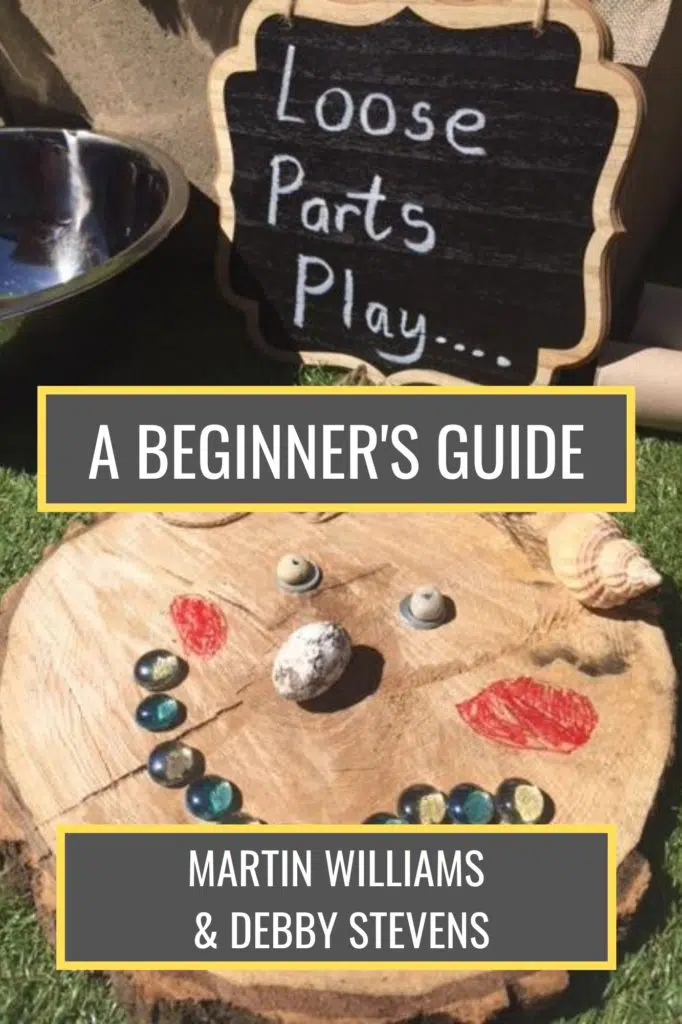
Conclusion
If you haven’t already, it really is time to give loose parts play a go. With just a few simple objects to start with, it provides a really cheap and fantastic remedy to life as a child in the modern world.
Children develop ownership of their own learning and of their lives.
Top Tips About The Benefits Of Loose Parts
- It is cheap or free
- In our technological society, it provides skills that may otherwise not develop
- They don’t get boring
- It is child-led
- You can develop skills across the whole curriculum.
If you have enjoyed this article, then why not check out one of these:
